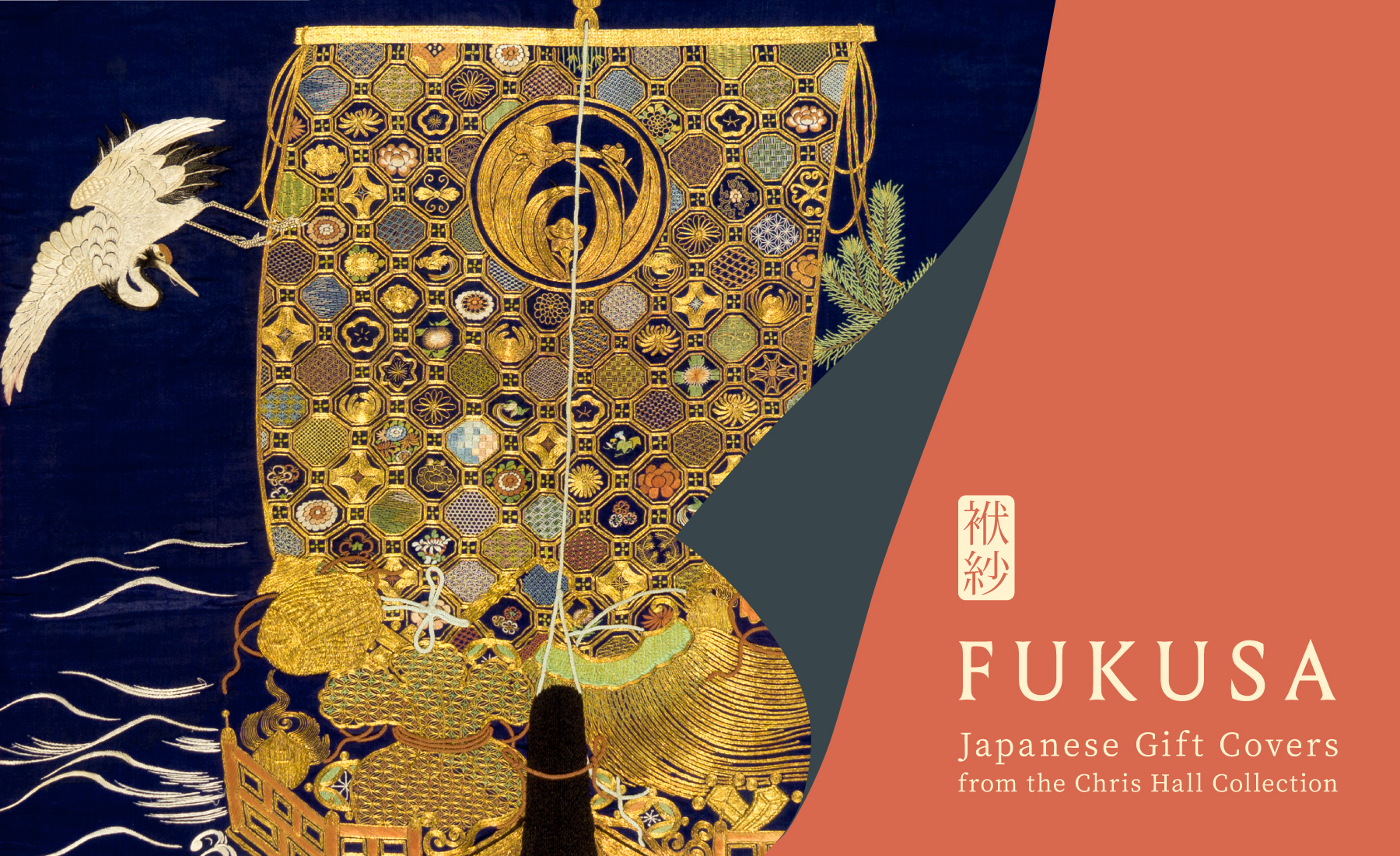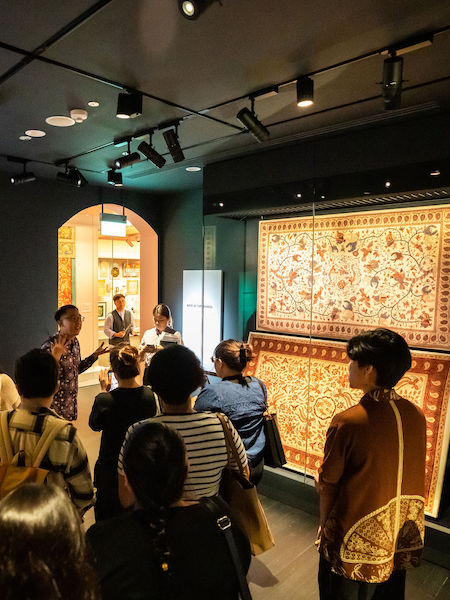Fukusa: Japanese Gift Covers from the Chris Hall Collection

Why and how do we give gifts? The act of gifting is deeply ingrained and takes many forms across histories and cultures. In Japan, the practice of formally presenting gifts with silk covers called fukusa began in the Edo period (1603–1868). These covers were draped or folded over gifts for a variety of occasions, from seasonal festivities to important personal events. Each fukusa was carefully chosen to evoke the circumstance of the gift and to convey a message to the recipient. Exquisitely embroidered, woven, painted, and dyed, they are some of the finest examples of Japanese textile artistry.
The exhibition presents a group of fukusa and related Japanese textiles from the renowned Chris Hall collection, explored through the themes of craft, trade and exchange, and the act of gifting across cultures. It celebrates a major gift of Japanese art from Chris Hall to ACM.
Exhibition Highlights

Fukusa with war fan and landscape
Late Edo or early Meiji period, 19th centuryEmbroidery, gold thread, stencil-dyed dots (suri-hitta) and paste-resist dyeing (yūzen) on figured silk satin
The composition of this fukusa is reminiscent of goshodoki (“palace landscape”) patterns reserved for the warrior class. The war fan is a reference to the owner’s military heritage. Suri-hitta dots add variety to the colourful landscape. In contrast to some yūzen-dyed textiles, in which fine details were painted with pigments at the end of the production process, the individual petals and leaf veins were created during the resist-dye process by leaving these outlines exposed in the dye bath.

Fukusa with women
Meiji period (1868–1912)
Embroidery and gold thread on silk satin
This rare depiction of women at leisure is a stark contrast to the male-dominated themes on many fukusa. The activities shown include playing music, applying cosmetics, dancing, tending to bonsai, ironing, calligraphy, and enjoying tea. The fukusa may have been given to a girl or young woman, perhaps as a representation of feminine self-cultivation and virtue.
The image echoes a genre of prints known as monozukushi – exhaustive depictions of things, animals, or people. The abbreviated forms of the figures also evoke the simple style of paintings that accompanied haikus. The seal at the lower right corner is probably the name of the woodblock artist, since embroiderers seldom signed their work.

Fukusa with shell-matching game
Meiji period (1868–1912)
Gold thread, embroidery, and paste-resist dyeing (yūzen) on plain weave silk
In the shell-matching game (kai-awase), the upper and lower halves of clam shells are painted with scenes and poems from classical literature. The aim is to pair each shell with its corresponding mate. The matching shape, speckling, and painted scene symbolise faithfulness and a well-matched couple. The shells were kept in two wooden boxes, often decorated with gold-sprinkled lacquer (maki-e) and secured with red cords. These materials are cleverly represented here with shimmering gold thread and red braiding on top of the dyed surface.
In the Edo period, the warrior elite and wealthy commoners often included the shell-matching game in the bride’s trousseau.
Programmes

The Art of Giving
Exploration Zone, Level 3
Pay it forward! Pass on the joy of giving and brighten someone else's day. Learn different embroidery stitches and create your own embroidered gift card. Pen a message on the card to take home or leave it on the display wall for the next visitor. Learn about the different weave patterns used in creating the fabrics for making fukusa. Experiment with crafting these patterns at the hands-on stations available in the space.
Download the embroidered gift card here.

Fukusa Activity Trail Pack
Navigate the special exhibition with a series of ten activity cards inspired by the fukusa, suitable for ages 7 and up, and learn more about the objects in the exhibition through fun filled activities. Explore related objects from the Peranakan Museum's permanent collection through the Can You Find Me? section in the activity cards.
Download the Fukusa Activity Trail Pack here.

Design your own Fukusa (The Art of Fukusa)
Level 2
Create your own fukusa design at a digital interactive station in the Special Exhibition Gallery, inspired by a loom. Discover what the motifs symbolise and see your designs come to life on a 4.5m by 5m large LED screen. Alternatively, download your creation and share the designs with your friends and family!

ACM CONVERSATIONS
Chris Hall: A Collector’s Journey
Saturday 20 April, 3-4 pm
Register here: https://chrishallcollectorsjourney.peatix.com/
Renowned textile collector Chris Hall discusses his approach to collecting and his work with cultural institutions around the world. Join in the conversation with Chris Hall and Director of ACM, Kennie Ting.
The ACM Conversations series is generously sponsored by Royal Insignia.

ACM CONVERSATIONS
Fukusa and the Culture of Spectacle in Premodern Japan
Dr Christine M.E. Guth
Thursday 25 July, 7-8 pmRegistration required
Fukusa, silk squares decorated with woven patterns, embroidery, or dyed in ink and colours, played a central role in ceremonial gift-giving in Japan between the seventeenth and late nineteenth centuries. Gifting was an essential part of social life, and the use of fukusa was embedded in traditions of formal etiquette that emphasised performance and display. More decorative than functional, they were draped over gifts on special occasions to add a layer of physical and metaphorical beauty that spoke to the refinement of donor and recipient alike.
This talk looks at fukusa as part of a wider culture of spectacle that includes the arrangement and display of artistic objects in reception rooms for visits from distinguished guests, the embellishment of garments, and the ornamentation of articles used in the tea ceremony. In so doing, it argues that today’s popular stereotype of premodern Japanese art as “minimalist” overlooks the rich diversity of its aesthetic traditions.

Curator Tours
15 May, 12 June, 17 July, 7 Aug, 7.30pm
$25 per participant
Registration here: https://acmcuratortours.peatix.com/
Go on a special after hours tour of the exhibition with curator Louise Lui.
About the curator
Louise Lui is Assistant Curator, Chinese Art at the Asian Civilisations Museum. She holds a BA in Art History from New York University and an MA in Decorative Arts, Design History, Material Culture from Bard Graduate Center, New York. Beforejoining the museum, she worked in the auction industry as a specialist in Chinese works of art.

Heritage Makers: Embroidery
11–12 May, 10am to 5pm
Weave your way to the museum this weekend as we explore the art of embroidery. Watch embroidery being done on a manual sewing machine, tour the galleries featuring beautiful embroidery textiles, discover the art of Japanese sashiko stitching, orizomegami techniques, and learn from Jackie Sam and Heath Yeo as they share their expertise on the craft.

Community Voices at Peranakan Museum
8–9 June, 10am to 5pm
Join tours and activities with the Peranakan community as they share special practices and customs inspired by gifting in Peranakan culture.
About Community Voices at Peranakan Museum
Immerse yourself in a weekend of Peranakan culture as our communities present their unique heritage in this quarterly series of programmes. Diverse Peranakan communities will share their knowledge and insights through performances, cooking demonstrations, crafts, and community-led tours of our galleries.

Gifting: Fukusa Weekend Festival
13–14 July, 10am to 5pm
Konnichiwa! Join us at craft workshops on embroidery and weaving and sake appreciation sessions. Discover the art of gifting through performances, special tours, experiences, and more!

Free Postcards* [Fully Redeemed]
To redeem:
1) Follow the Peranakan Museum on Instagram.
2) Show that you have followed us on Instagram and present your Fukusa admission sticker at the Level 1 Visitor Services Desk to redeem a postcard. (1 card per person)
3) Use the stamps available to customise your own postcard.
4) Return the stamps to their original positions for the next visitor to use.
We would love to see your creations!
Tag us at @peranakanmuseum
*While stocks last



